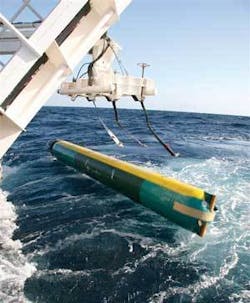Unmanned underwater vehicle advancements surface at 2006 Sea-Air-Space exposition
By Courtney E. Howard
WASHINGTON - Major industry players demonstrated the first solutions to support the U.S. Navy’s Mission Reconfigurable Unmanned Undersea Vehicle System (MRUUVS) master plan during Navy League’s 2006 Sea-Air-Space exposition last month.
The Navy’s MRUUVS program, now more than ever, is at the forefront of many contractors’ research and development efforts, given that leaders of the Naval Sea Systems Command (NAVSEA) intend to award a contract for the program by the end of September.
In support of the MRUUVS plan, contractors are designing and building UUVs for intelligence, surveillance, and reconnaissance (ISR), as well as for mine countermeasure exploratory reconnaissance. The fruits of their labor garnered significant attention at the 2006 Navy League show.
“Right now, MRUUVS is a key program,” says Tom Jones, director of marine systems at Boeing Integrated Defense Systems in Anaheim, Calif. “Everyone wants to win that. It will establish a lot of the future for different industry players, so we’re focusing a lot of attention there.”
Boeing designers demonstrated their Long-term Mine Reconnaissance System (LMRS) through the use of video footage, animation, and a small-scale model.
Boeing’s LMRS 20-foot UUV is designed to be impulse launched in the same style as is a torpedo from Los Angeles- and Virginia-class attack submarines, yet unlike torpedoes, the LMRS is built to withstand several impulse launches.
It is capable of surveying underwater objects such as tethered and bottom mines for as long as 60 hours using two sonar systems, a computer, and an inertial navigation system.
Upon completion of its mission, the unit docks and the submarine’s 60-foot robotic arm recovers the UUV through the torpedo launch tube. Once on board, experts retrieve and analyze the UUV’s surveillance data.
To date, Boeing’s LMRS has achieved two milestones: it is the first UUV not only to launch like a torpedo, but also to dock while the submarine is underway.
“We proved that it is possible for a heavyweight-class UUV to autonomously perform complex maneuvers, overcome hydrodynamic forces, and successfully dock to a submarine while both are underway,” Jones says.
Also at Navy League, leading engineers from the BAE Systems London office delivered a technology demonstration of the Talisman UUV, which made its U.S. debut at the show. The company’s latest UUV officially launched during Oceanology International at the end of March.
The BAE Systems Talisman, measuring 5 by 3 meters in size, has a hull containing commercial-off-the-shelf (COTS) vectorable thruster pods, enabling it to maneuver accurately, hover, and turn 360 degrees. At the same time, the modular multi-role UUV is designed to be autonomous, network-centric, and mission-reconfigurable.
The Talisman’s design enables various mission- or role-specific payload options, ranging from sonar systems to smaller UUVs. Autonomous operation comes from pre-setting the parameters of its mission-planning utilities. Further, the vehicle’s open architecture enables technicians to reconfigure it quickly for various missions, whether deployed underwater or on the water’s surface.
In a show of confidence at the future of UUVs, officials of General Atomics in San Diego revealed they are entering the market. The company-which has affiliate General Atomics Aeronautical Systems Inc., maker of unmanned aerial vehicles including the Predator series-is in the beginning stages of a new program to design and develop UUVs.
General Atomics engineers are focusing their attention on antisubmarine warfare (ASW) specifications, whereas many contractors are focusing research and development efforts on meeting the Navy’s requirements for MRUUVs.
“We’ve decided to make a contribution in this area and find a role that we can fulfill, and we think that’s going to be in a larger UUV that can carry larger payloads and we’ve launched a program to go work in that area,” says Mike Reed, director of the General Atomics Electromagnetic Systems Division.
“We have looked at what other people are doing, and we have decided to focus on a larger platform aimed toward a future ASW-type mission,” Reed says. “That kind of vehicle could take on surveillance, reconnaissance, mine-hunting, and antisubmarine warfare roles.”
Reed anticipates that the U.S. Navy is likely to invest in ASW UUVs some time in the not-too-distant future.
The current MRUUV program is garnering significant attention from contractors. General Atomics leaders considered the MRUUV master plan, and found that several companies have been involved in the program for years.
“I think less attention has been given to larger platforms and the ASW role,” Reed notes. “There’s an opportunity for someone to get a head start on developing a system that might help fill that void when the Navy is ready to go that way with the program. It’s an area where there’s an opportunity to make the largest contribution.”
The MRUUVS is expected to achieve initial operational capability in 2011.

